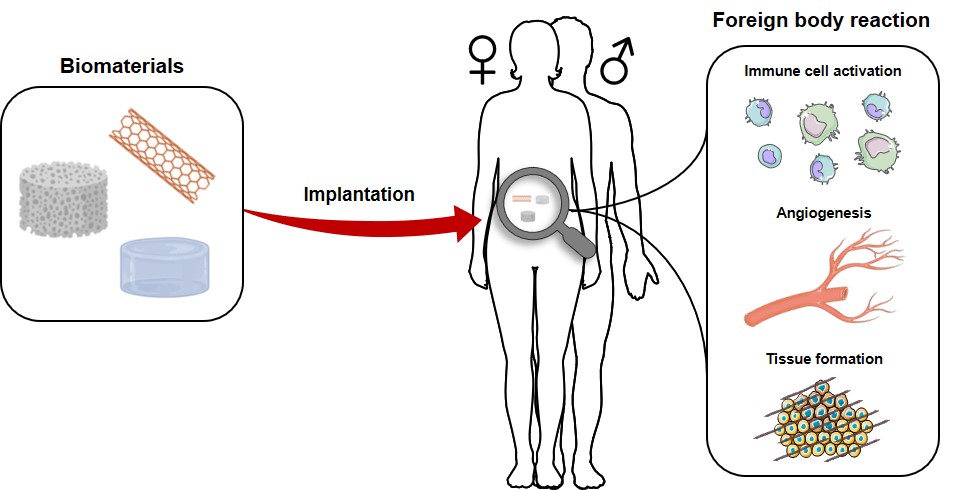Sex-specific foreign body reactions to implanted biomaterials
The implantation of biomaterials into the human body represents an integral part of many modern therapeutic approaches in the field of regenerative medicine and tissue engineering. For this purpose, the biomaterials should exhibit a good biocompatibility to guarantee their long-term function and safety. The foreign body reaction to biomaterials is a dynamic and complex process, which is crucially determined by individual biological mechanisms. These include the activation and recruitment of different immune cell subtypes, angiogenesis and the formation of new extracellular matrix components at the implantation site. Although gender is known to influence each of these mechanisms, sex-specific effects on the foreign body reaction have been neglected in biomaterial research so far. To address this important issue, we will study the sex-specific acute and chronic foreign body reaction to different types of biomaterials in murine in vivo models by means of high-resolution imaging technologies. This will enable us to clarify, which biomaterial properties or modifications provoke fundamentally different reactions in females and males, and, thus, to set the basis for personalized biomaterial implants of the future.

Project lead
Prof. Dr. med. Matthias W. Laschke, Ph.D.
Saarland University
Institute for Clinical-Experimental Surgery

PD Dr. rer. nat. Emmanuel Ampofo
Saarland University
Institute for Clinical-Experimental Surgery
Important publications
- Nalbach L, Müller D, Wrublewsky S, Metzger W, Menger MD, Laschke MW, Ampofo E. Microvascular fragment spheroids: Three-dimensional vascularization units for tissue engineering and regeneration. J Tissue Eng 12:20417314211035593, 2021
- Später T, Marschall JE, Brücker LK, Nickels RM, Metzger W, Mai AS, Menger MD, Laschke MW. Adipose tissue-derived microvascular fragments from male and female fat donors exhibit a comparable vascularization capacity. Front Bioeng Biotechnol 9:777687, 2021
- Nalbach L, Roma LP, Schmitt BM, Becker V, Körbel C, Wrublewsky S, Pack M, Später T, Metzger W, Menger MM, Frueh FS, Götz C, Lin H, Manning Fox JE, MacDonald PE, Menger MD, Laschke MW, Ampofo E. Improvement of islet transplantation by the fusion of islet cells with functional blood vessels. EMBO Mol Med 13:e12616, 2021
- Später T, Tobias AL, Menger MM, Nickels RM, Menger MD, Laschke MW. Biological coating with platelet-rich plasma and adipose tissue-derived microvascular fragments improves the vascularization, biocompatibility and tissue incorporation of porous polyethylene. Acta Biomater 108:194-206, 2020
- Schmitt BM, Boewe AS, Becker V, Nalbach L, Gu Y, Götz C, Menger MD, Laschke MW, Ampofo E. Protein kinase CK2 regulates nerve/glial antigen (NG)2-mediated angiogenic activity of human pericytes. Cells 9:1546, 2020
- Laschke MW, Augustin VA, Sahin F, Anschütz D, Metzger W, Scheuer C, Bischoff M, Aktas C, Menger MD. Surface modification by plasma etching impairs early vascularization and tissue incorporation of porous polyethylene (Medpor®) implants. J Biomed Mater Res B Appl Biomater 104:1738-1748, 2016
- Laschke MW, Vollmar B, Menger MD. The dorsal skinfold chamber: window into the dynamic interaction of biomaterials with their surrounding host tissue. Eur Cell Mater 22:147-164, 2011

